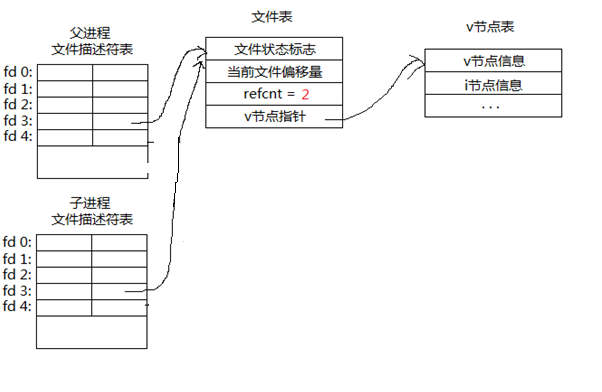一:system系统调用 #include <stdlib.h> int system(const char *string); system函数传递给/bin/sh -c 来执行string所指定的命令。 string中可以包含选项和参数 如果没有找到/bin/sh。函数返回127,如果出现其他错误返回-1,成功返回0,但如果string为NULL,返回一个非0值 system调用其他进程是通过shell调用其他进程,本程序进程与被调用的进程之间没有关系。
#include <stdio.h> #include <stdlib.h> #include <string.h> #include <errno.h> #include <unistd.h> #include <sys/types.h> int main(int arg, char * args[]) { system("ls -l"); return 0; }
二:fork系统调用 #include<unistd.h> pid_t fork(void); fork执行成功,向父进程返回子进程的PID,并向子进程返回0,这意味着fork即使只调用一次,也会返回两次。 fork创建的新进程是和父进程(除了PID和PPID)一样的副本。 父进程和子进程之间有点区别,子进程没有继承父进程的超时设置(使用alarm调用)、父进程创建的文件锁,或者未决信号。 但是子进程会继承父进程的文件描述符,内存空间大小,代码 你不能预计父进程是在他的子进程之前还是之后运行,他的执行是无序的,是异步的。 fork的异步行为意味着你不应该在子进程中执行依赖与父进程的代码,反之亦然。 fork调用可能失败,原因是系统上已经运行了太多进程,已经超过了允许他执行的最大进程数。 fork执行失败,会向父进程返回-1,而且不创建子进程,更新errno。
fork执行成功,向父进程返回子进程的PID,向子进程返回0。
#include <stdio.h> #include <stdlib.h> #include <string.h> #include <errno.h> #include <unistd.h> #include <sys/types.h> int main(int arg, char * args[]) { pid_t child=fork(); if(child==-1) { printf("操作系统出错! "); return -1; } if(child==0) { //此时在子进程中 printf("child is begining! "); sleep(200); printf("child is end! "); }else { //此时在父进程中,child大于零,child的值就是子进程的PID printf("parent is begining! "); sleep(200); printf("parent is end! "); } /* 通过观察"/proc"下的父子进程,发现父子进程共用一段代码 */ return 0; }
当进程执行到fork()函数的时候,会复制自身,创建一个新进程,父进程,子进程都会执行fork()函数,
子进程的代码执行将会从fork()函数开始,而不是重新将所有父进程代码执行一遍(因为这样会出现重复执行fork函数,不断的创建新进程)
fork系统调用的特殊之处在于一段代码在不同的两个进程中运行(例如if的两个分支)
#include <stdio.h> #include <stdlib.h> #include <string.h> #include <errno.h> #include <unistd.h> #include <sys/types.h> int main(int arg, char * args[]) { int i=0; for(;i<2;i++) { pid_t child=fork(); } /* 这样会创建4个进程,分别是2个父进程,2个子进程 这其实很像一棵树 父进程A执行第一次循环,生成子进程B,此时父进程A中child=子进程B的PID;子进程B的child=0 当父进程执行第二次循环,生成子进程C,此时父进程A中child=子进程C的PID;子进程C的child=0 但是此时子进程B会执行fork()函数之后的代码,所以子进程B会再次执行一次fork()函数, 此时系统会复制子进程B成为一个新的孙子进程D,那么子进程B就会变成一个父进程。 */ return 0; }
//fork函数共享文件标识符 #include <stdio.h> #include <stdlib.h> #include <string.h> #include <errno.h> #include <unistd.h> #include <sys/types.h> #include <sys/stat.h> #include <fcntl.h> int main(int arg, char * args[]) { if(arg<2) { printf("请输入一个参数! "); return -1; } int fd=open(args[1],O_WRONLY); if(fd==-1) { printf("error msg:%s ",strerror(errno)); return -1; } //create new process pid_t child=fork(); if(child==0) { sleep(3); printf("child is beining "); //child process //write the file char buf[30]={0}; int index=0; strcpy(buf,"fly on air! "); index=write(fd,buf,strlen(buf)+1); printf("write count :%d ",index); //close the file /* 对close()函数加强 close()关闭是对文件标识符的引用减一,直到对文件标识符的引用变成0,该文件才会真正关闭 当执行fork()函数后对文件标识符fd引用就变成两个, fd同时被父进程和子进程所引用 所以单独在父进程或者子进程中close()并无法关闭文件引用 必须同时在父进程和子进程关闭引用 */ close(fd); printf("child is end "); }else { printf("parent beining "); close(fd); printf("parent is end "); /* 函数名: exit() 所在头文件:stdlib.h(如果是”VC6.0“的话头文件为:windows.h) 功 能: 关闭所有文件,终止正在执行的进程。 exit(0)表示正常退出, exit(x)(x不为0)都表示异常退出,这个x是返回给操作系统(包括UNIX,Linux,和MS DOS)的,以供其他程序使用。 */ exit(0); //程序exit(0)后面的代码都不会执行,此时进程已经退出 printf("l am not protect! "); } printf("all end! "); return 0; }

详解:程序在fork()函数之前open()打开一个文件描述符fd3,这个文件描述符指向一个文件表A(fd3类似于一个指针,指向一个文件表的内存区域),
执行fork()函数后,当子进程中使用了文件描述符fd3时,那么Linux内核会写时拷贝fd3文件描述符到子进程中,此时子进程中的fd3文件描述符也指向
同一个文件表A(类似于两个指针指向同一片内存),此时Linux内核会将refcnt这个值加1,表示现在有2个进程引用该文件描述符所以关闭该文件表,
需要在父进程和子进程中分别关闭。